Sales plan – what is it and how to create one?

Imagine a pilot taking off without a flight path, no destination in mind, and no compass or radar in the cockpit. You’re flying, sure—but where to? And at what cost? Lack of a sales plan is one of the most common reasons behind poor performance, vague sales goals, and low team efficiency.
But a successful sales planning process is much more than a spreadsheet filled with numbers. It’s a map—a structured, measurable system that combines market analysis, insights about potential customers, awareness of current industry trends, and clear goal-setting principles. With it, building a sales strategy becomes a logical process, not a game of chance.
In this article, we’ll walk you through how to create a sales plan that truly works—one that supports real growth, regardless of your company’s size or industry.

What Is a Sales Plan and Where Should You Start?
A sales plan is a strategic document that outlines your company’s sales goals, how to achieve them, and what resources, actions, and timelines are required. It includes market analysis, a description of your target audience, lead generation strategies, role assignments within the team, and key performance indicators (KPIs). The main objective is to structure your sales processes and drive predictable revenue growth.
Before you set targets or plan initiatives, you need to start with the fundamentals. A strong sales plan is built on real data—not assumptions.
The first step is analysis: understand the market landscape, your competitors, emerging trends, and your target customer. Without this insight, your sales activities will be scattered and ineffective.
Next, define your sales goals—make them measurable, ambitious, and aligned with both your team’s capabilities and the buyer’s journey.
Only then should you move into execution: choose your sales channels, tools, and assign responsibilities. And remember—your plan needs to be flexible. That’s why involving your sales reps in the process is crucial—they’re the ones with hands-on knowledge of the market.

Market Analysis – The Foundation of an Effective Sales Strategy
Building a successful sales plan starts with a strong foundation. Without in-depth market analysis, even the most well-designed sales methodologies or ambitious business goals can miss the mark. For sales business leaders looking to increase efficiency, improve accuracy in revenue goals, and truly increase sales, market intelligence is the non-negotiable first step.
According to research from Hanover Research, market analysis provides a comprehensive view of your target markets—including market size, customer segments, growth constraints, competitive positioning, and future opportunities. This knowledge is especially crucial when planning for enterprise companies, where every product or service needs to solve a specific pain point and offer tangible business value.
Why Market Analysis Is a Game-Changer
An effective marketing strategy should always align with real-world market dynamics. Market analysis allows sales and marketing teams to:
- Understand current sales trends and anticipate future shifts in buyer behavior.
- Identify and refine customer personas to ensure messaging resonates with the right audiences.
- Optimize team structure and allocate sales development reps to high-potential verticals.
- Inform sales training plans by aligning content with evolving customer needs.
- Choose the right sales methodologies—such as SPIN Selling, consultative selling, or value-based selling—based on buyer preferences and competitive pressures.
This intelligence helps align both inbound sales strategies and outbound efforts with the realities of the market, increasing the quality of inbound leads and the effectiveness of prospecting outreach.
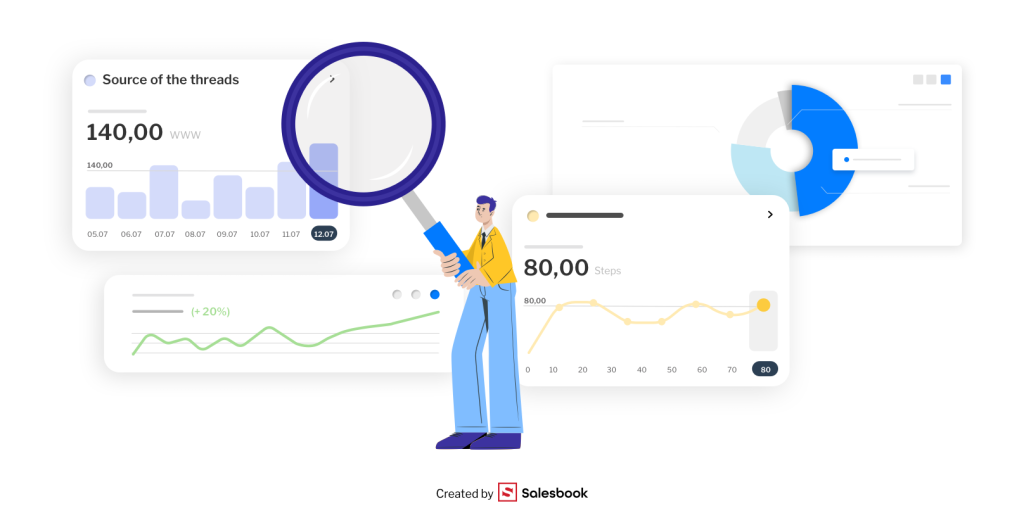
From Insights to Execution
When you know what drives your prospective customers, what language they use, where they consume content, and what objections they typically raise, your sales organization is equipped to build a more relevant and actionable sales business plan. This directly contributes to customer relationship development and accelerates pipeline movement.
Market analysis also helps answer critical strategic questions:
- Which customer segments are underserved?
- How much revenue goals are realistic within a 6–12 month period?
- What sales materials and messaging frameworks should be used at different stages of the funnel?
- Which sales tactics will resonate best with each product or service offering?
How to Research Your Competitors and Understand Customer Needs
Start by analyzing your competition—identify the key players in your space, examine their offerings, pricing models, sales channels, and communication strategies. Use tools like SimilarWeb and Semrush to gain insights into their online activities and performance.
At the same time, get to know your target audience. Surveys, interviews, customer reviews, and social media analysis can help you uncover what your customers truly expect—and what drives their buying decisions.
Keep an eye on broader market trends as well: shifts in technology, evolving customer needs, and regulatory changes all impact the effectiveness of your powerful sales strategy.
And remember—analysis is not a one-time task. It’s an ongoing process. Regularly updating your data is essential for making accurate decisions and achieving your sales goals.

Defining Your Company Mission and Building an Effective Sales Plan
Before your sales team starts chasing targets and your marketing team launches campaigns, you need to answer one key question—for yourself and the entire organization: Why do we do what we do?
This is where your company’s mission comes into play. It sets the direction, meaning, and foundation for everything that follows—including your sales planning.
Your Mission Is the Compass of the Sales Plan
A mission isn’t just a slogan on a poster. It’s a clear declaration of the value you aim to deliver to customers, the change you want to create in your market, and the reason your business exists.
Without it, building a strong sales plan becomes difficult—because there’s no way to tell whether your actions are aligned with real value or just chasing short-term numbers.
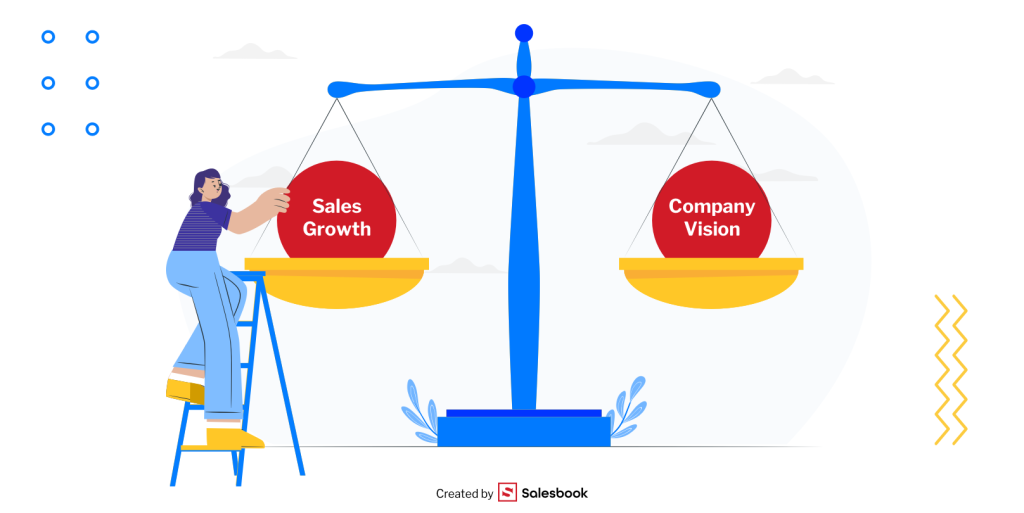
Sales Goals – How to Set and Measure Them
There’s no such thing as an effective sales plan without well-defined goals. Sales goals are the backbone of your strategy—they shape everything from budgeting and timelines to forecasting methods and team performance evaluations.
Why Are Sales Goals So Important?
Strong sales goals aren’t just numbers in a spreadsheet—they’re strategic tools that guide decision-making. They help clarify expectations, motivate your team, streamline lead generation, and most importantly, enable accurate forecasting and intentional revenue growth.
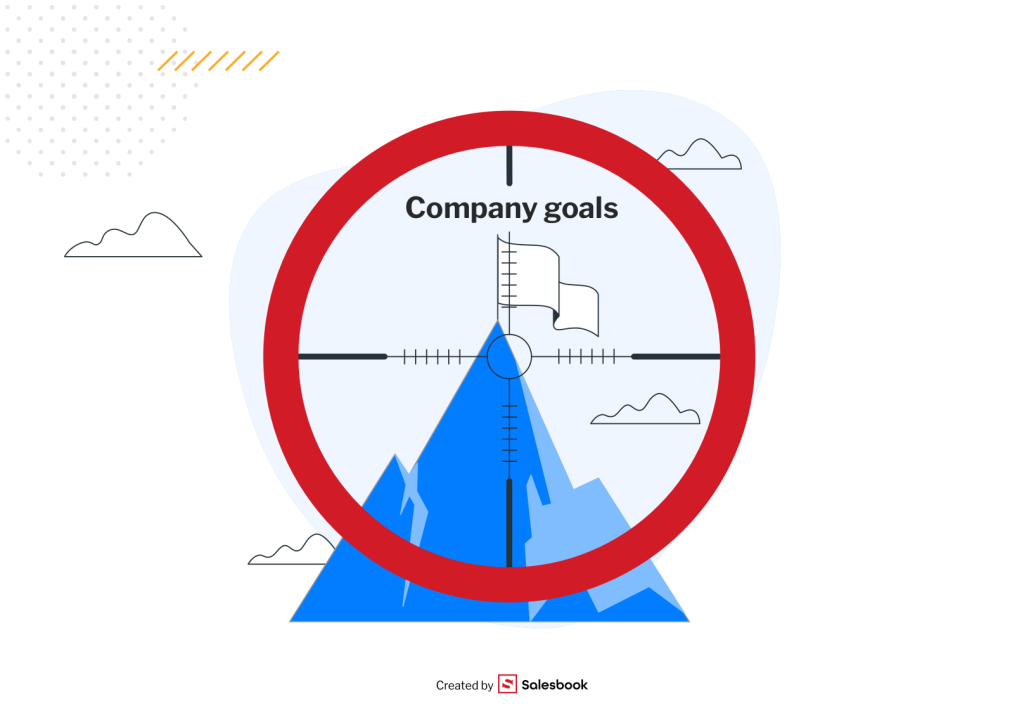
On the flip side, poorly defined goals can lead to demotivation, operational chaos, and a lack of accountability. Even worse—they can distort your true business performance and hide potential risks lurking in the pipeline.
Where to Begin?
Before jumping into the numbers, you need to answer a few foundational questions:
- What exactly do we want to achieve—both quantitatively and qualitatively?
- How does that translate into product or service sales?
- What historical data do we have, and what can it teach us?
- Who is responsible for achieving targets at each stage of the funnel?
At this stage, it’s worth diving into past performance reports, CRM analytics, and marketing data. These will help you build a sales plan that is both ambitious and realistic.
From there, you can choose the right framework for goal setting—SMART, KPI, or OKR?

SMART, KPI or OKR – Which Goal-Setting Framework Works Best in Sales?
Each of these approaches addresses different needs, but they all share one purpose: turning plans into measurable outcomes. Below, we break them down from the perspective of a modern sales leader.
1. SMART – The Classic Operational Goal Framework
SMART stands for: Specific, Measurable, Achievable, Relevant, and Time-bound.
SMART goals are perfect for day-to-day sales execution, especially for sales reps and team leaders who need clarity and accountability.
Example:
Increase the number of signed contracts by 15% in Q3 2025 within the SME segment.
It’s specific, measurable, and realistic. This framework is ideal for building action plans, setting quarterly targets, and creating accurate sales forecasts.
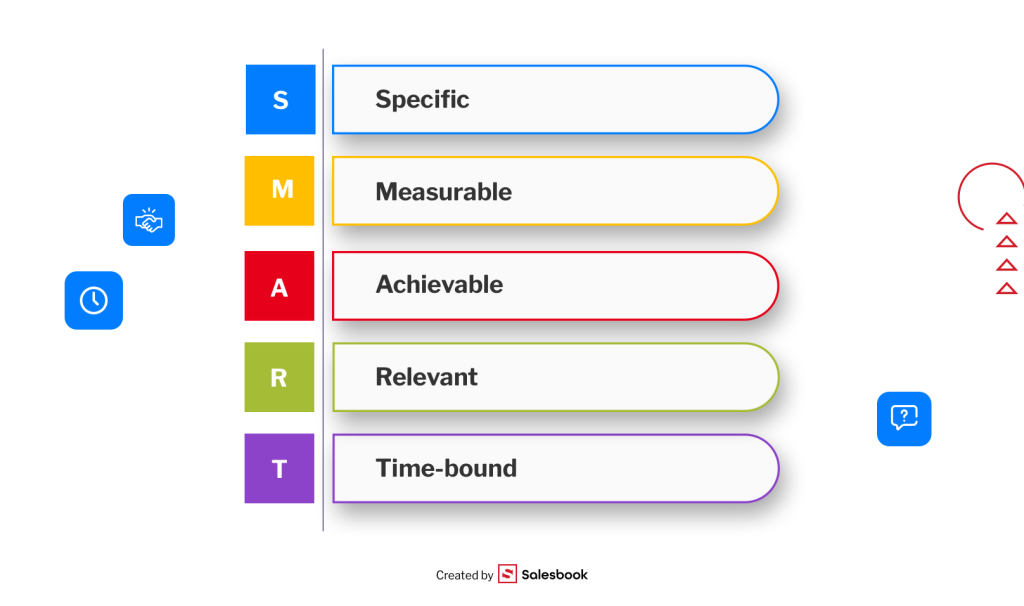
2. KPI – Strategic Performance Control
KPI (Key Performance Indicators) are metrics that measure the effectiveness of your actions at the process level. In sales, they might include:
- Number of leads generated per month
- Average sales cycle length
- Average contract value (ACV)
- Conversion rate from product demo to signed contract
KPI help you quickly identify deviations from the norm and take corrective action early. They are essential if you want your sales plan to be truly data-driven and continuously optimized.
3. OKR – Ambitious Goals at the Organizational Level
OKR (Objectives & Key Results) is a goal-setting framework used by companies like Google, HubSpot, and Asana. It’s ideal when you want to:
- Drive deeper engagement across your team
- Align your sales department with other parts of the organization
- Set bold goals and encourage long-term, strategic thinking
Example OKR in sales:
Objective: Dominate the industrial automation market in Poland
- KR1: Close 60 new deals with manufacturing clients by the end of Q4
- KR2: Increase MRR from this segment by 30%
- KR3: Build two new sales channels
OKRs are ambitious—but that’s their strength. They fuel progress, stretch team potential, and help create a culture of high performance—not just goal execution.
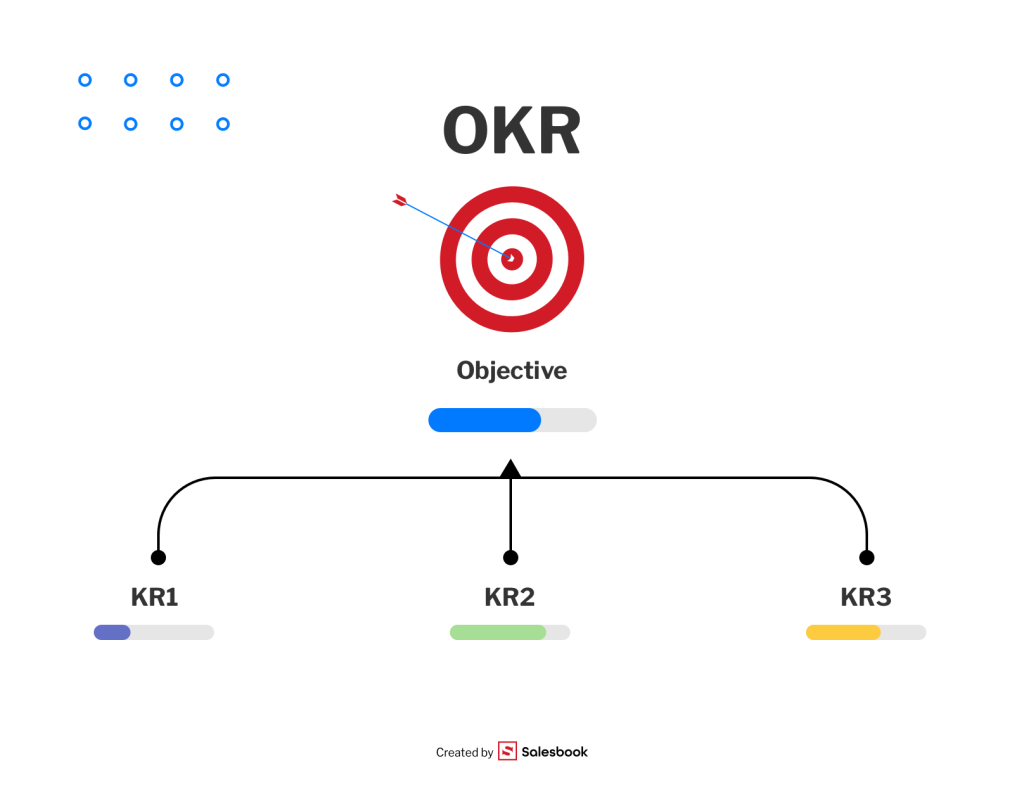
Which Approach Should You Choose?
There’s no one-size-fits-all answer. In practice, most companies combine these approaches:
- SMART for the day-to-day goals of individual sales reps
- KPI for measuring performance and tracking process efficiency
- OKR for driving ambitious, strategic change
The key is alignment—your goals must connect to your company’s mission, overall strategy, and operational plan. That’s the only way to build a sales plan that works over time and scales alongside your business.
What Should a Good Sales Plan Include?
A good sales plan isn’t a vague collection of ideas or a slide for the next board meeting. It’s a detailed, actionable document that organizes your goals, tactics, and execution methods. Ideally, it allows every member of your sales team to answer the following:
- What exactly are we trying to achieve?
- What actions and tools are planned to get us there?
- Who is responsible for what?
- What is the timeline and order of execution?
- How will we measure progress?
Only a plan in this format enables effective coordination, accurate forecasting, reduced chaos, and successful execution at both the strategic and operational levels.
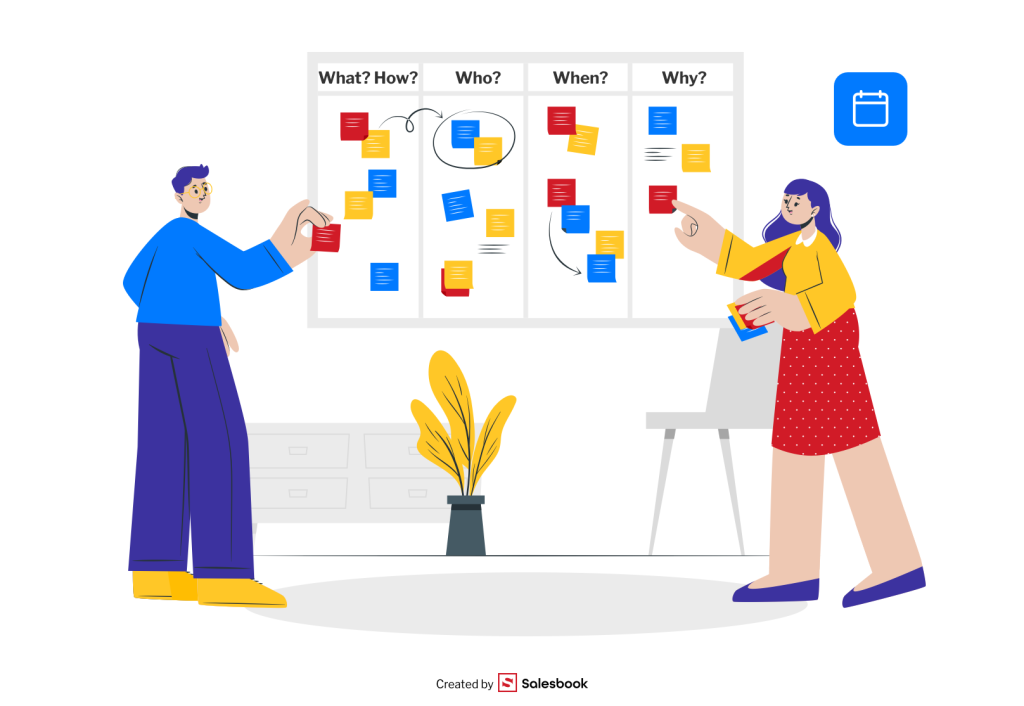
Structure, Timeline, and Accountability – Essential Components of a Sales Plan
To make your sales planning truly effective, the document should include at least five core sections:
- Sales goals – clearly defined, measurable, and broken down into stages (e.g., monthly or quarterly)
- Situation analysis – a concise overview of the market, target audience, competition, and current challenges
- Action timeline – structured into phases such as prospecting, demo, negotiations, and closing
- Responsibility matrix – assigning specific tasks to individuals or roles within the sales team
- Success metrics – KPIs that track progress and help you react quickly to deviations
Additionally, it’s worth including sections for tools, budget allocation, and a list of potential risks along with mitigation strategies (e.g., seasonality issues or customer churn).
How to Create a Sales Plan Step by Step
Creating a sales plan requires a logical sequence of actions. No matter your company size, industry, or sales model (inbound or outbound), the same framework applies:
analysis → goals → strategy → actions → control
Below, you’ll find a detailed step-by-step guide you can adapt to fit your organization.

Step 1 – Gather Data and Conduct a Situational Analysis
- Collect historical data: number of leads, sales cycle length, win rates, conversion sources
- Conduct market and competitor analysis: What trends are shaping your industry? Which segments show the most potential?
- Review internal resources: How many salespeople do you have? What’s their capacity? What budget do you have?
Outcome: You gain an objective view of your starting point and what’s realistically achievable.
Step 2 – Define Your Target Group and Buyer Personas
- Who is your ideal customer? (Industry, job title, company size, pain points)
- What does their decision-making process look like?
- What blocks or motivates them? What content do they consume? Where do they spend time?
Step 3 – Set Sales Goals
- Goals should follow the SMART framework—specific, measurable, achievable, relevant, and time-bound
- Break goals into categories:
- Quantitative (e.g., number of signed deals)
- Qualitative (e.g., customer satisfaction)
- Behavioral (e.g., number of weekly meetings)
- Divide goals into phases—quarterly, monthly, weekly—for better progress tracking
Step 4 – Develop Your Sales Strategy and Actions
- Choose your sales channels: outbound, inbound, partners, events
- Plan activities: cold calls, demos, nurturing, ABM campaigns
- Define the process: who contacts the client, when, with what materials, and what the message should be
Don’t forget to include supporting activities and automation elements wherever possible to streamline your workflow.
Step 5 – Define the Timeline and Responsibilities
- Assign specific actions to individuals or teams
- Set key milestones: campaign launch, CRM rollout, first demos, initial orders
- Schedule weekly or biweekly checkpoints to monitor progress and adjust when needed
Step 6 – Choose Metrics and Monitoring Methods
- Define your KPIs: conversions, number of meetings, average deal value, CAC, LTV
- Set up a reporting system: dashboards, automated CRM reports, deviation alerts
- Stay flexible: the market evolves, and your plan should evolve with it.

Sample Sales Plan Template You Can Use
Below is a universal template you can adapt to your organization. It works well for both startups and companies scaling their B2B sales operations.
H3: Free Sales Plan Template
1. General Information
- Company / Department: Salesbook
- Plan Duration: Q3 2025
- Responsible Person: Jan Kowalski, Head of Sales
2. Situation Analysis
- Market trends: Growing demand for production automation solutions
- Key competitors: Company A, Company B (SWOT analysis)
- Historical insights: Average sales cycle – 47 days, demo-to-close rate – 22%
3. Target Group
- Industries: Manufacturing, logistics
- Job titles: Operations Director, Head of Automation
- Pain points: High labor costs, need to scale without hiring
4. Sales Goals
- Quantitative: 60 new contracts
- Revenue-based: 25% increase in MRR
- Qualitative: NPS above 8.5
5. Sales Strategy
- Channels: Outbound (Lemlist), inbound (webinars, whitepapers), industry events
- Tactics: Email sequences, call-backs, case studies, product consultations
6. Action Timeline
- Week 1–2: Prospecting + list building
- Week 3–4: Outbound campaign + demo invites
- Week 5+: Nurturing + deal closing
7. Responsibilities
- SDR: Prospecting and first contact
- Account Executive: Demos, negotiations, closing deals
- Marketing: Supporting materials, lead scoring
8. Monitoring & Reporting
- KPIs: Weekly meetings booked, demo effectiveness, deal value
- Reporting tools: CRM + Salesbook dashboard, weekly status meetings
A document like this creates a shared language across your organization. It enables reliable forecasting, performance evaluation, and scalable sales execution. In short—it’s the foundation for predictable growth.
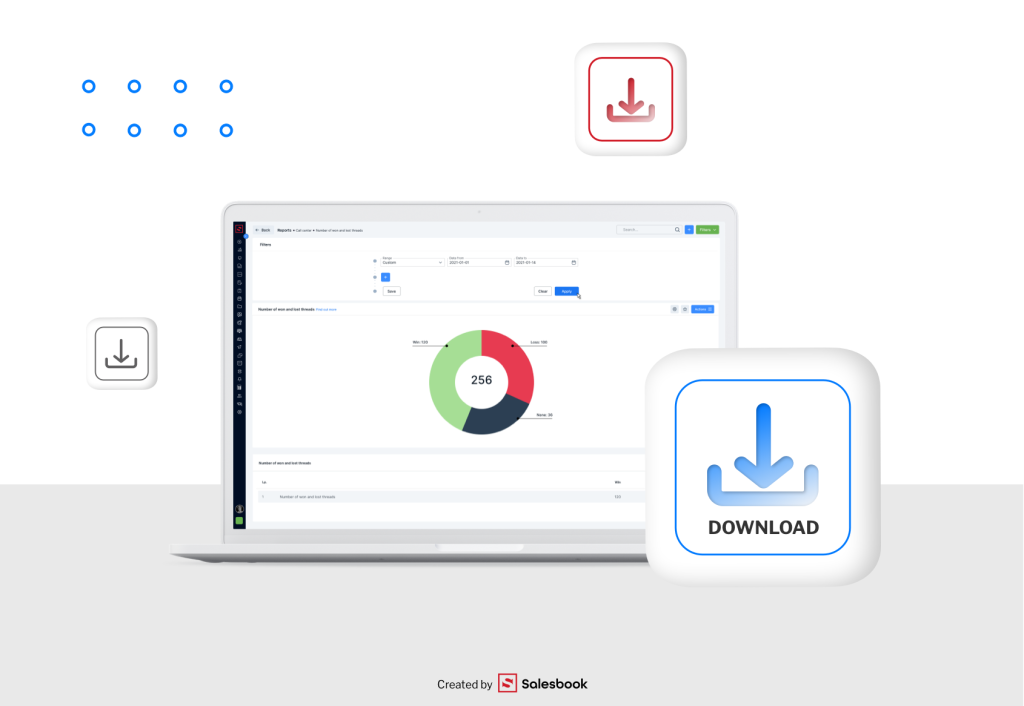
How to Match the Right Sales Activities to Your Goals
The goals are set, the plan is approved, and your company’s vision is clearly defined. So—what’s next? It’s time to move from planning to execution. But not all actions drive results—especially when they’re misaligned with your strategic sales plan, audience, or funnel stage.
That’s why every sales effort must be intentional. Choosing the right sales tactics requires a direct link to your earlier analysis of historical data, your inbound or outbound sales strategy, and the maturity of your sales pipeline. The goal isn’t just activity—it’s targeted execution that drives real business growth and helps you hit your sales targets and broader revenue goals.
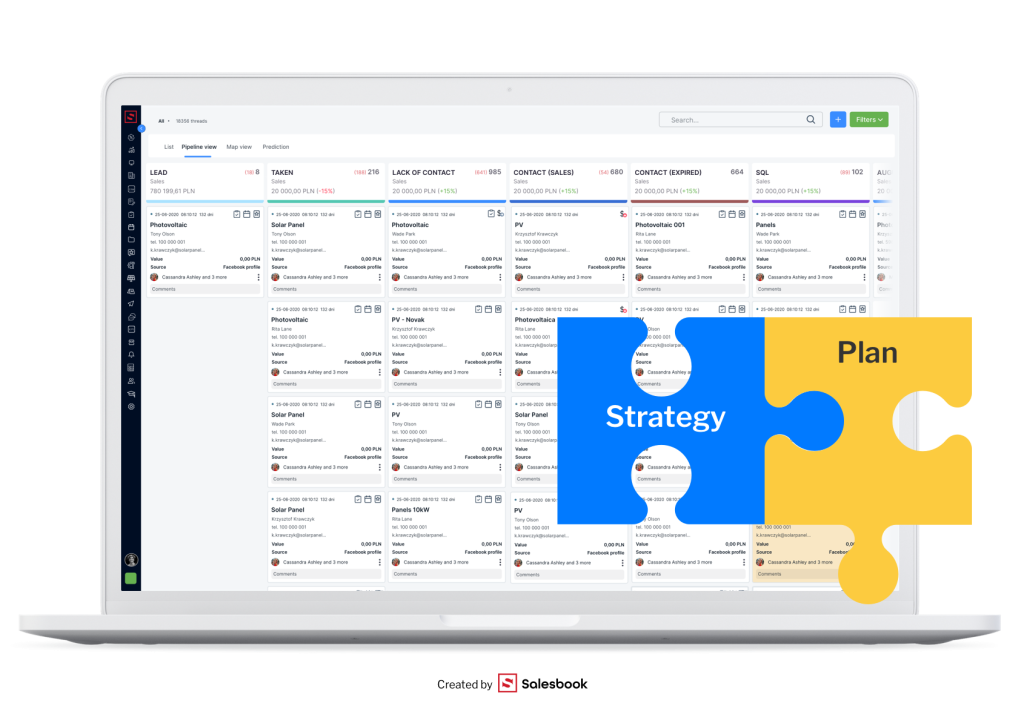
Aligning Actions with Goals and Target Audience
Every objective in your sales strategy plan should be paired with specific actions that directly support its achievement. This approach ensures your team isn’t just busy—it’s productive and outcome-focused. Here are a few practical examples:
Goal: Increase lead volume from the mid-market segment by 20% in Q3
Recommended actions: Deploy a strong inbound sales strategy using gated content, run educational webinars tailored to mid-market pain points, and apply advanced lead scoring to qualify prospects. These sales tactics can significantly boost top-of-funnel performance and create predictable sales forecasting opportunities.
Goal: Shorten the sales cycle by 10 days
Recommended actions: Simplify your offering to reduce friction, create an on-demand demo experience to accelerate evaluation, and use automation tools for faster follow-ups. These steps can dramatically improve sales performance across the funnel and make it easier for sales representatives to close deals faster.
Goal: Increase revenue from existing customers by 15%
Recommended actions: Launch an upsell campaign with clear value-adds, initiate strategic call-backs led by senior sales managers, and develop cross-sell flows based on CRM and product usage insights. These actions help align ongoing sales efforts with long-term revenue goals.
Ultimately, your successful sales strategy depends not just on what you do—but how well each action fits your goals, audience, and stage in the funnel. Enterprise clients may require more strategic dialogues, ROI-driven messaging, and high-touch engagement, whereas SMBs may respond better to short demos, personalized pricing, and quick follow-up from sales professionals.
If your activities don’t directly support your sales targets or forecasted revenue outcomes, they need to be re-evaluated. Matching the right actions to the right goals is how smart companies turn strategy into sales success.
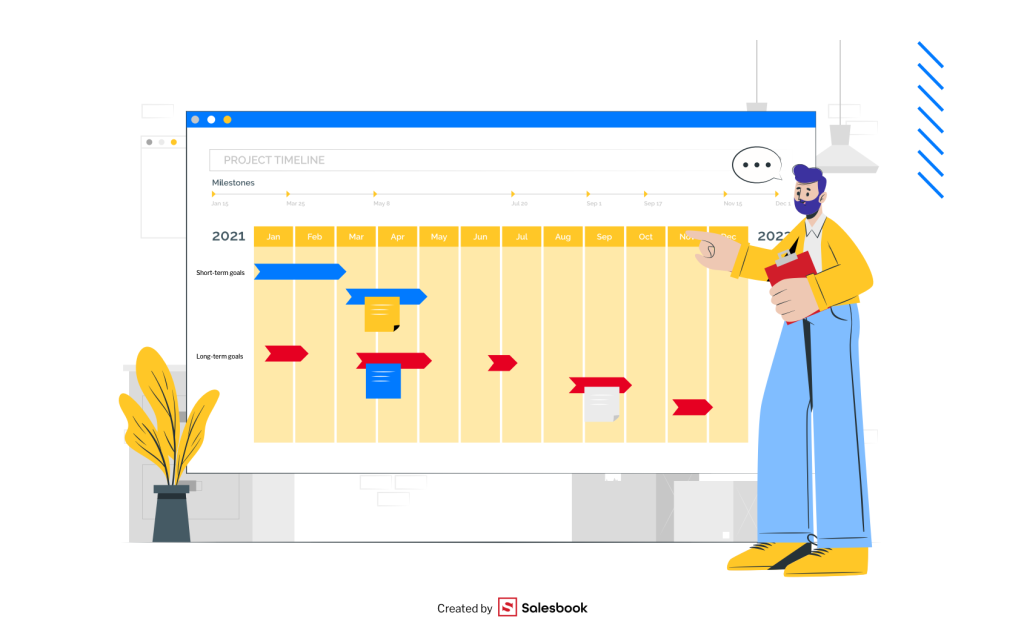
Is a Sales Plan a One-Time Document? How Often Should You Update It?
Absolutely not—a sales strategy plan should never be seen as a one-time project. It’s a living document that must evolve alongside your business. As markets shift, customer expectations change, and new technologies emerge, your sales plan must adapt in real time to remain effective.
Keeping your sales plan current is critical to staying aligned with your revenue targets, optimizing your sales pipeline, and ensuring your efforts support a winning sales strategy. Without regular updates, even the most well-thought-out plan can quickly become outdated, leading to misaligned priorities, missed opportunities, and reduced cost savings in execution.
Recommended update frequency:
- Quarterly – Review and fine-tune operational activities, based on current customer data, team performance, and pipeline dynamics. This ensures you’re addressing real-time shifts in the market and making tactical adjustments that support short-term growth.
- Biannually – Reevaluate your overall sales strategy plan and revenue targets. Use this time to integrate learnings from previous campaigns, refine messaging, and make structural changes if needed.
- Ad hoc – Update your plan when facing major changes, such as a new competitor entering the market, a disruptive customer relationship management tool being implemented, or significant shifts in technology or buyer behavior.
Regular updates to your sales plan ensure it remains relevant, actionable, and grounded in current business conditions. More importantly, they enable you to scale strategically, maintain visibility across your sales pipeline, and stay focused on achieving measurable results with efficiency.
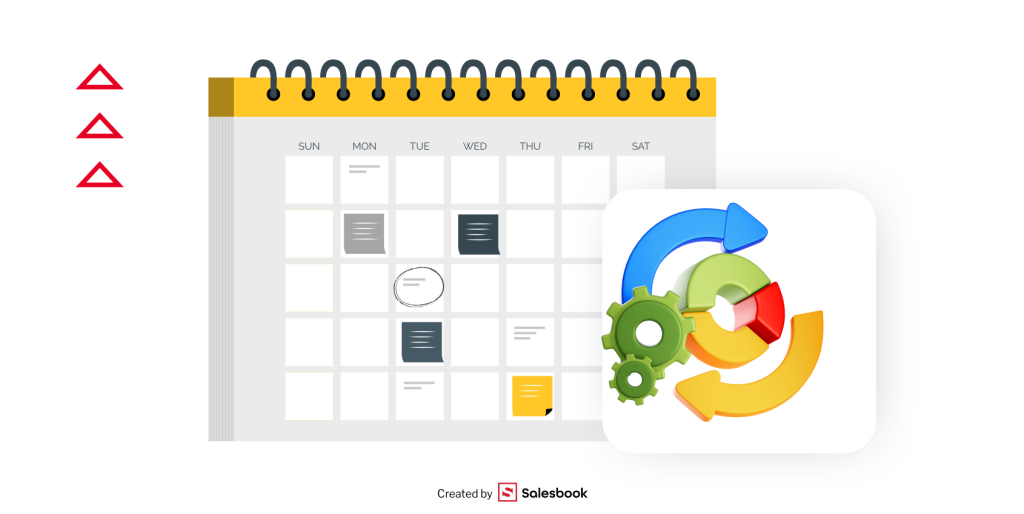
Summary – Why a Sales Plan Is Essential for Every Company
Without a plan, you’re flying blind. With a plan, you have a map, a compass, and full control over your direction.
Creating a sales plan means:
- Setting measurable goals
- Aligning your actions with your target audience
- Building a predictable, scalable growth system
This isn’t a luxury—it’s a necessity if you want to grow revenue, develop your team, invest your budget wisely, and stay aligned with your company’s vision.
A well-designed sales plan is one of the most powerful sales tools for staying competitive today—and one of the smartest moves any B2B company can make for the future sales.
Table of Contents







